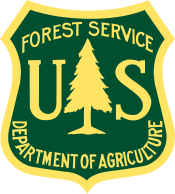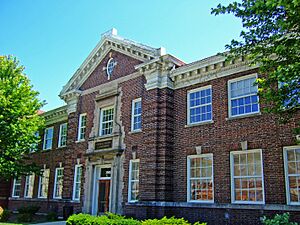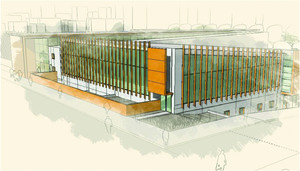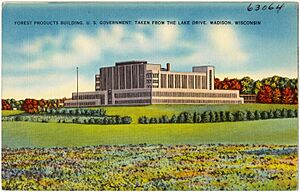Forest Products Laboratory facts for kids

Logo of the US Forest Service.
|
|
| Agency overview | |
|---|---|
| Formed | June 4, 1910 |
| Jurisdiction | Federal Government of the United States |
| Headquarters | 1 Gifford Pinchot Drive, Madison, WI 53726 |
| Agency executive |
|
| Parent agency | US Department of Agriculture United States Forest Service |
| Website | www.fpl.fs.fed.us @fsWoodLab |
The Forest Products Laboratory (FPL) is a special research lab for the United States Forest Service. This service is part of the USDA. Since it opened in 1910, the FPL has studied wood and wood products. They also look at how wood can be used in different ways. They work with universities, businesses, and other government groups. The lab is located in Madison, Wisconsin. The main goal of the FPL is to help keep forests healthy. They do this by finding smart and lasting ways to use wood from our country's forests.
History of the FPL

The idea for the Forest Products Laboratory started in 1907. A man named McGarvey Cline saw that a central research place was needed. This would help different research centers work better together. He and Forest Service Chief Gifford Pinchot chose the University of Wisconsin campus for the new lab.
The lab officially opened on June 4, 1910. It was first located at 1509 University Avenue. This building is now part of the UW Materials Science and Engineering Building. In 1932, the FPL moved to its current location. This is on the western side of the University of Wisconsin campus.
Over the years, FPL research has made life better for many people. They have helped with breakthroughs in housing, packaging, and recycling. They also helped protect our forest resources. The FPL has also done important work for the country during wars. This included key research for the armed forces.
What the FPL Does
The Forest Products Laboratory wants to find new ways to use wood and wood fibers. This helps protect forests and keeps them productive. It also supports the economy and improves our quality of life. The FPL has seven main research groups. These groups use many labs and information centers at the FPL campus. All FPL research focuses on five main areas. They work with other government groups, businesses, and universities on this research.
Cool Research Areas
- Using Unused Wood: Forests in the United States have a lot of small trees and wood that isn't used. Too many trees can cause big wildfires. They also make forests more likely to get sick or damaged by insects. Thinning out these trees can help. But it can be expensive. The FPL looks for ways to use this extra wood. This helps make thinning more affordable. It also creates new products and jobs. For example, they've explored using small trees for bridges, boardwalks, and picnic shelters.
- Tiny Tech: Nanotechnology: Nanotechnology is about working with super tiny materials. The FPL is a leader in using this technology for wood products. Imagine wood materials with tiny sensors inside! These sensors could measure how strong a building is. They could also check for moisture or heat. Other ideas include coatings for wood that stop germs or water. This could make wood last longer in wet or stormy areas. They also make strong, lightweight products from tiny wood parts called nanocrystals. These can improve things like fiberboard and particleboard.
- Making Fuel and Products from Forests: The FPL researches how to turn wood into fuel, energy, and chemicals. This helps lower the cost of managing forests. It also makes forests healthier and reduces our need for fossil fuels. Plus, it helps lower greenhouse gases that cause global warming. Forests have a lot of wood that needs to be removed. This is because fires have been stopped for many years. This wood can be used to make products, chemicals, and energy. Using wood for fuel is often seen as good for the environment. This is because trees take in carbon dioxide as they grow.
- Designing Stronger Buildings: In the past, buildings were mostly designed to be safe. Now, engineers also think about how buildings work, their impact on the environment, and their cost. This is called "performance-based engineering." It means designing buildings that can handle future challenges. This approach uses science to predict how a building will perform. It also involves checking the building's health over time. This helps us know when buildings need repairs or new construction.
- New Wood Materials: Advanced Composites: For many years, wood composite materials have been used to make things like plywood and particleboard. These are used in homes and buildings. More recently, new materials made from natural fibers have appeared. These include wood-plastic composites. The FPL is also working on "nano-enabled composites." These are special materials that use nanotechnology. They add a lot of value to different kinds of wood and plant fibers. This includes small trees, farm waste, and recycled materials. These new materials help forest managers restore damaged forests. They also promote lasting forest management.
Research Teams at FPL
- Durability & Wood Protection: This team makes wood last longer and protects it better. They work on better building designs, safer wood treatments, and fire safety.
- Economics & Statistics: This group provides information about the cost of wood products. They also help make research more effective using modern statistics.
- Engineered Composites Sciences: This team studies how materials, processes, and performance are linked. They create new wood composites that help people and use forest resources in a lasting way.
- Engineering Properties of Wood, Wood-based Materials & Structures: This team studies the strength and other qualities of wood. This helps engineers design better wood buildings.
- Fiber & Chemical Sciences Research: This group finds ways to turn wood into chemicals and fibers. They also find uses for wood that isn't used much. They improve ways to recycle wood products like paper and building waste.
- Institute for Microbial & Biochemical Technology: This team uses biotechnology and nanotechnology to change wood and fibers. Their research helps use wood efficiently and keeps forests healthy.
- Forest Biopolymer Science & Engineering: This team studies the basic qualities of wood and other materials used with wood. They aim to make these materials better and find new uses for them.
Special Labs at FPL
- Analytical Chemistry & Microscopy Laboratory (ACML): This lab helps FPL researchers by using special tools. These tools include a nanoindenter (to test tiny hardness), an atomic force microscope (to see tiny surfaces), and a scanning electron microscope (to see very small details).
- Engineering Mechanics & Remote Sensing Laboratory (EMRSL): This lab tests the strength of many materials and building parts. They test everything from small pieces of wood to full-size building sections. This helps create building codes and structural designs.
- Paper Test Laboratory: This lab mainly checks the quality of paper used for printing and writing. They can test paper for strength, how it looks, and its surface. They do this in a room with controlled humidity for very accurate results.
Helpful Resources & Support
- Center for Wood Anatomy Research: This center has the world's largest collection of research wood. It has over 100,000 samples! Researchers use these samples to study wood and identify different types. They can also answer questions about wood from tropical or less common native trees.
- Center for Forest Mycology Research: This center studies fungi (like mushrooms). They have a collection of 70,000 dried fungi samples and 12,000 living fungi. Researchers worldwide use these collections for their studies.
- Technology Marketing Unit: This unit helps small, rural forest products businesses. They share knowledge about using and selling wood products. They also help with new technologies. They offer publications, visits, workshops, and phone help. They also give out grants to help use wood from forest restoration projects.
- FPL Library: The FPL has a national Forest Service library that is open to everyone. It has books and information on many topics. These include wood products, paper, fungi, wood engineering, and recycling.
Cool Research & Testing Facilities
Centennial Research Facility

The Centennial Research Facility (CRF) is a big, new lab at the FPL. It's about 87,000 square feet! This building was designed to be very eco-friendly. It meets the Silver certification from the Leadership in Energy and Environmental Design (LEED) system. This means it saves energy and water. It also reduces pollution and uses resources wisely. In the CRF, researchers can test the strength of full-size buildings. Other researchers can test wood products in a special chamber that simulates harsh weather. This new facility helps advance research in wood and bio-based materials.
Research Demonstration House and Carriage House
The FPL has built two full-size buildings: the Research Demonstration House and the Carriage House. These are used for research and teaching. They let researchers study housing in a real-world setting. This helps them learn even more than they could in a lab. These buildings are part of a project started in 2000. Many groups work together to improve housing technologies.
Fire Test Lab
The fire testing lab at FPL is very important. It helps create safe building products. The lab can do standard tests to see how well materials resist flames and fire. They are also planning a new fire test facility. This new lab will be able to simulate real fire situations on a larger scale. This will help researchers understand wildland fire threats to buildings. It will also help create better building codes for fire safety.
Pulp & Paper Plant
The FPL has a special plant that can copy industrial pulping and papermaking processes. It's like a mini-factory! They can make wood chips, pulp, paper, and fiberboard. They can even recycle materials. This lets researchers test new methods. They can see how well they work on equipment similar to what big companies use.
Nanocellulose Pilot Plant
In 2012, the FPL opened a new facility to make nanomaterials from wood. This was the first of its kind in the United States! It makes the FPL a top producer of nanocellulose materials. Nanocellulose is wood fiber broken down to a super tiny size. A nanometer is about one-millionth the thickness of a dime! Materials this small have amazing properties. Nanocellulose can be stronger than Kevlar (a very strong material) and is very lightweight.
Imagine using nanocellulose in lightweight armor or super strong glass! Companies in the car, airplane, electronics, and medical industries are very interested in these materials. This facility will help create new jobs in forestry. It could also add a lot of money to the American economy. Using these new wood-based materials can help reduce how much fossil fuel we use. It also lowers greenhouse gas emissions. Plus, it creates new manufacturing jobs in rural areas. The FPL's new plant helps researchers and companies get the nanocellulose they need to develop these amazing new products.
Images for kids
-
Results of strength tests for different designs of a DeHaviland wing rib during World War I.



